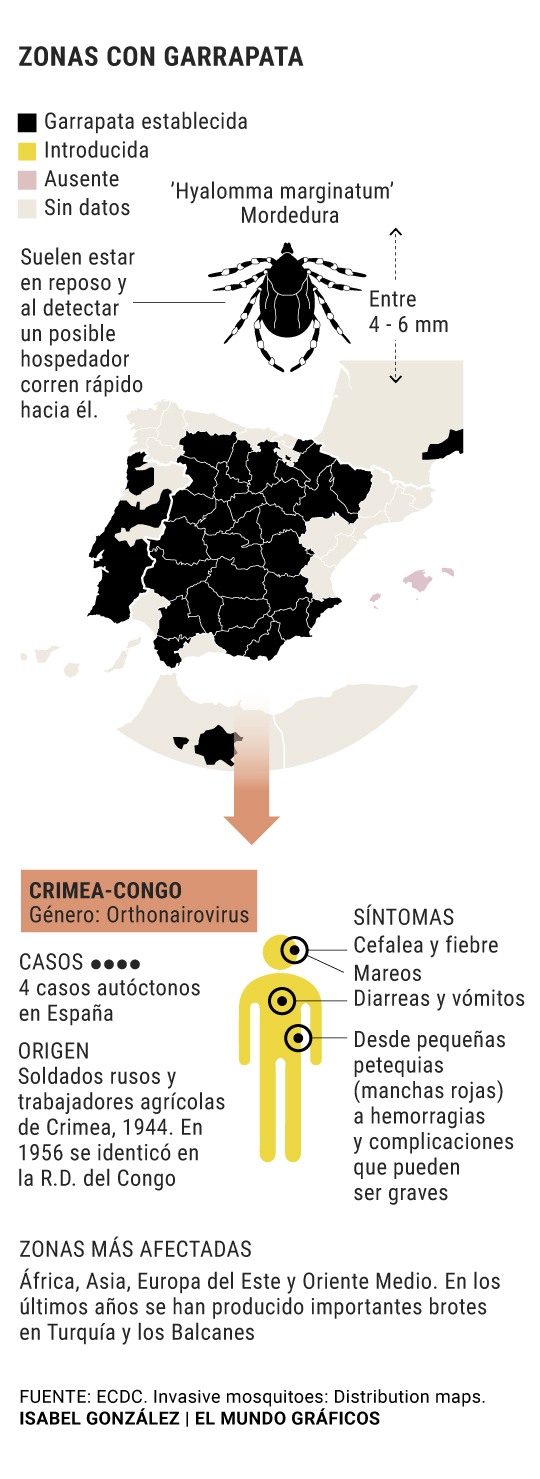- Health: A man dies from the bite of a tick that transmits Crimea-Congo fever
- Graph.The most frequent ticks in Spain and the diseases they transmit
A middle-aged man remains admitted to the Clinical Hospital of Salamanca, stable within gravity, with Crimea-Congo hemorrhagic fever after being infected by a tick bite . Nine other people who had contact with the man remain under observation.
The Minister of Health of Castilla y León, Verónica Casado, explained today in a press conference after the Governing Council that the sting occurred at the end of May in an area of pine forests in the province of Salamanca, but it was this Wednesday by the afternoon when the Carlos III Health Institute confirmed the infection.
The affected suffered severe muscle pain and a very high fever , the symptoms of this infection, according to the counselor, who added that after learning of this case, the health services began to analyze the close contacts of this person, initially identifying nine. These people are being controlled, especially their body temperature (one of the first manifestations of the infection).
The so-called Crimean-Congo haemorrhagic fever is an anthropozoonosis derived from the nairovirus and is considered an emerging disease in Western Europe, normally transmitted by a tick bite, but, once infected, it can be spread by contact with blood, secretions or other bodily fluids.
For this reason, the counselor has recommended that, when going to natural areas where this insect can be found, such as pine forests, long sleeves are used in both pants and T-shirts, as well as repellents.
With the coronavirus crisis still on the table, many people may be alarmed that this is the next epidemic, but for now there is no reason for concern. This is the fifth case that has occurred in Spain since the virus was first identified in 2010 in ticks of the H. lusitanicum species captured in deer on a farm in Extremadura.
It was not until September 2016 that the diagnosis of the first indigenous case in Spain was made . The patient, a 64-year-old man who died, produced a secondary case in one of the nurses who treated him while he was admitted to the ICU of the Hospital Infanta Leonor in Madrid. In August 2018, two other indigenous cases were confirmed in the country, although without apparent relationship.
Health does not rule out the sporadic appearance of new autochthonous human cases since the Crimean-Congo hemorrhagic fever virus circulates in a wide area of Spain. "The risk that there will be more sporadic cases of transmission of the Crimean-Congo haemorrhagic fever virus in Spain is moderate in areas where there is a presence of ticks of the Hyalomma genus and especially in the population with greater exposure to their bites that resides or frequent those areas. "
This is the case of the autonomous communities of Madrid, Castilla y León, Castila-La Mancha and Extremadura. However, "the impact of the disease is considered low given that although it may be a serious disease, the number of people affected would not be high."
In accordance with the criteria of The Trust Project
Know more- Science and health
- Infectious diseases
- Salamanca
- Health
Health "ICUs are a safety net, the rest have to work better"
Health "It is possible that a vaccine cannot be developed, that it takes time to arrive or that it is not effective"
Coronavirus Journal from the ICU (24): "Healthcare professionals suffer a new disorder: roller coaster syndrome"
See links of interest
- News
- Translator
- Programming
- Calendar
- Horoscope
- Classification
- League calendar
- Films
- Schools
- Masters
- Cut notes
- Rich
- Universities
- Themes
- Coronavirus
- Rosa Maria Sarda
- Rayo Vallecano - Albacete
- Seville - Real Betis

